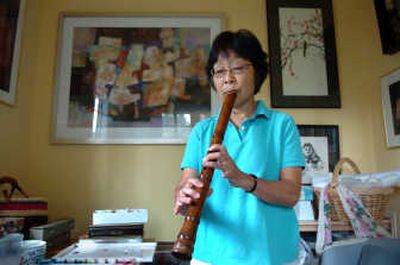Olivia Waterman

Art form: Water-media painting on paper, sumi-e, painting on silk.
Best known for: Her combination of water-soluble mediums like watercolor, inks, gouache, acrylics, water-based oils and watercolor crayons.
Major art influence: Major influences include Mark Rothko, Richard Diebenkorn, Diego Riveria, Hakuin Ekaku and Qi Baishi. She is drawn to those artists “because of their strong visual statements plus competence with color and composition,” she says.
Other influences closer to home are her sumi-e teacher Keiko Von Holt and watercolorist Don Napean of Spokane because “they taught me how to be more competent with the medium and are fine examples of thoughtful, caring and knowledgeable artists and teachers,” she says.
In addition, artist Richard Bohn’s work “inspires me and encourages me to paint from the heart rather than for commercial reasons.”
When did you start making art? “My first love of art began when my mother gave me my first oils at about age 8,” says Waterman.
“I spent many busy hours painting,” she says. Along with a friend, Waterman would pass more hours drawing cartoons and comic book characters.
Waterman started getting serious about art in college.
“Since then,” she says, “I haven’t stopped painting except for a brief respite to raise a family. Like most artists, I often held jobs while continuing to paint.”
Process: Waterman uses a variety of gel mediums which result in a wide-range of textures. In addition, she pours or applies many layers of paints, often using isopropyl anhydrous alcohol to rub off parts of the layers to enhance textural variation.
What’s new? Waterman recently started shakuhachi (Japanese flute) lessons from James Hunter.
“I fell in love with the bamboo they are made of,” she says, “and have tried to incorporate bamboo into my paintings or paint it. I also am now trying to incorporate Japanese and Chinese traditional painting into contemporary Western pieces.”
What keeps you creating? “When you are working on a piece and everything – line, rhythm, color, composition, form, value contrast – comes together, you experience a ‘high,’ a thrill, an indescribable exhilaration, a spiritual feeling,” says Waterman.
“This experience is difficult to achieve on every painting,” she continues. “Thus one keeps creating, attempting to capture that allusive special feeling again. In the end, one hopes others experience the same aesthetic response while seeing the finished work, much like listening to a beautiful piece of music.”